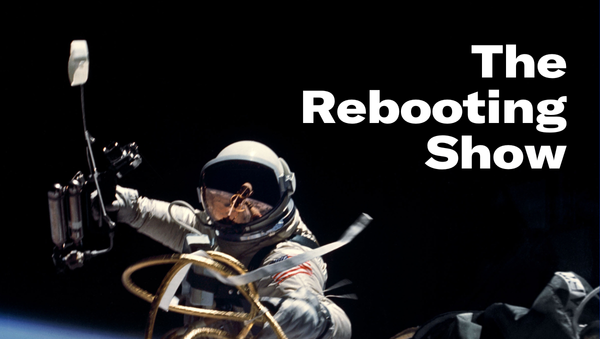Product problems
Skift's Rafat Ali on why mainstream media is "obsolete"
Thanks to everyone who signed up for The Rebooting’s membership program. I really appreciate the support. Consider becoming a member today. The Pro membership tier is $200 and the heavy hitters can opt for $1,000 Insider tier. I got a lot of good feedback on the program, and I am incorporating it into how I roll it out. “Your writing has helped me shape my perspective on the industry,” one new member wrote me. “Happy to support your independent media play.” Less successful with the Australian creative director who replied “Nahhhh.” Will put them in the “maybe” bucket.
Rethink what’s possible

In the dynamic landscape of tech, media, and consumer trends, clinging to the familiar might feel like the right choice. But what if the true potential for your brand goes beyond the comfort of what you know?
It's time to reimagine the possibilities on the open web – a powerful, yet overlooked medium for reaching consumers in the consideration phase. Unlock the potential to elevate brand impact, quantified through attention metrics, in this intentional environment and discover the high-value purchase power of this audience segment.
Enter Onyx by Outbrain™ – where beautiful outcomes come to life through impactful creative solutions designed for attention. Rethink what’s possible.
Product problems
The media industry has a product problem. It is losing badly to TikTok, Instagram and algorithmic feeds. Netflix has lapped the content-is-king crowd while YouTube is the new cable bundle. The pivot to subscriptions is flagging at many middle-market news publications. Facing with a rematch of octogenarian politicians rehashing their greatest hits, people are tuning out political news.
The tendency is to point blame at external forces, usually tech platforms that have proven far more adept at capturing attention and ad budgets. But the inconvenient truth is that the media industry hasn’t kept pace with changing habits, new distribution patterns, shifting consumer expectations and the need for new ways to make money. The answers to these challenges cannot be newsletters and events.
Rafat Ali is someone I’ve known for over two decades, sharing the distinction of both working for Jason Calacanis. Rafat chronicled the initial struggles of the media business to adapt to the commercial internet as the founder of PaidContent. He went on to found Skift, a B2B travel media brand.
Rafat joined me, Troy Young and Alex Schleifer this week on People vs Algorithms to discuss the so-called extinction event unfolded in parts of the media business and why much of it comes down to a product problem.
“Culturally mainstream media is obsolete,” Rafat said.” Nobody wants it. You can argue all they want is confirmation bias. What they don't want is what the mainstream media is offering.”
CNN under Mark Thompson is sounding the right notes about adapting to a “mobile-first world” and the rest. But Rafat sees an obsolete product in a world where viewpoints are increasingly formed by YouTube and TikTok. “Under no circumstance, however they think about the product, is anybody going to pay for CNN today in this world.”
Rafat is hinting at a stagnation that’s settled into the publishing industry. Individual brands are lapping institutional brands. The era of experimentation with new distribution approaches led by BuzzFeed has faded. The endless debate about replacing the third-party cookie has devolved into pleading to Google and other tech companies to figure it out. There’s little talk of how to capture new opportunities with the Vision Pro.
“The digital market economics don’t currently leave space for experimentation and punishes failure fast right now,” one media exec recently told me
New Washington Post CEO Will Lewis is right that too little has been done to find new ways for people to pay for news. Shifting from hard paywalls to dynamic paywalls is hardly a major shift. The news industry needs a far broader revenue base than the small percentage of the audience willing to pay for a subscription. Alex often asks why the gaming industry has come up with so many ways for people to pay for content while news is stuck with broadly the same models as a generation ago. A growth agenda has to start with the product itself.
Many publishers are finding subscriptions stall out because they had unrealistic expectations for how much of their audience they could get to pay. That’s a product problem. Subscriptions are often grafted onto models built around advertising or sponsorship. The most successful subscription models I see change the focus of the organization to direct revenue while, of course, continuing to operate the other business lines because this is the media business.
TechCrunch would seem an ideal test case for subscriptions. It is a leading brand in the highest-growth, most lucrative business sector. But its subscriptions program didn’t work. It’s little surprise when TechCrunch was relying on contributed pieces and struggled to have the kind of expertise needed. Everyone wants Politico Pro, but that means having deep expertise. The risk for publications like TechCrunch is those with the expertise are expensive, and individuals are building strong businesses without all the overhead that comes with institutional media organizations.
This is the peril of getting caught in the middle, and the middle class in media is vast but shrinking. Chuck Lapointe, CEO of local news publisher Narcity Media in Canada, sees a further “reckoning” this year for the publishers reliant on search and social for distribution and advertising for monetization.
For many mid-market publishers, there’s little hope of building a mini-version of the Times. One former exec at one of these companies recently explained the impossible path to reach some of the goals originally set for new subscription plans.
“There is simply no level of investment in content, products, technology, or marketing that will enable that kind of change in the growth rate. Nor are their any signals from consumers that the market is ready to purchase the company’s offering at that scale. It is a pipe dream.”

Go vertical
EX.CO’s new vertical video player for publishers has a first-of-its-kind, interactive UX, inspired by the video experience on social platforms. Built for both desktop and mobile, the player delivers 17% more video engagement than traditional horizontal players and allows viewers to easily swipe through an endless stream of videos.

On this week's show, we cover why Vision Pro matters and the inexorable shift of the internet to content coming to people rather than them going to the content. We're also joined by Rafat to discuss his "grand theory of media."
Recommendations
Scenes from the glue factory. News publishing brands don’t die, they just get harvested for their SEO. (Wired)
Meet Lit. Hank Medina, the man behind the finance meme media company Litquidity is no longer pseudonymous. BI did the sleuthing, but the FT wins with the memeable quote that Medina was “an Amazing Excel guy.” (FT)
ClownCo 2.0. Media companies are running back NewCo but for sports. (Madison & Wall)
Embracing AI. Politico, whose owner cut a deal with OpenAI, is formatting its content to be more easily understood by AI crawlers. (Press-Gazette)
Hope in local. 6am City raised a $10 million Series A led by Tegna, as it looks to newsletters to power an efficient local model that mostly skips hard news. (Axios)
Thanks for reading. Sign up for The Rebooting’s membership program. Next week, I’ll start experimenting with member content. Send me your feedback: bmorrissey@therebooting.com.




